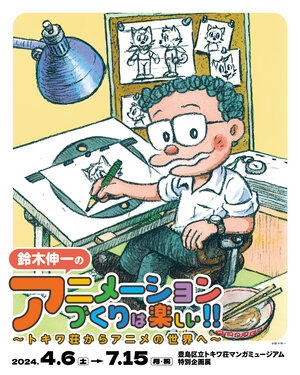Special Exhibition "Shin'ichi Suzuki's Joy of Animation: From Tokiwaso to the World of Anime"
Dates Saturday, 6 April 2024 - Monday, 15 July 2024
1. Outline of Exhibition
"Ramen-loving Mr. Koike" is an eccentric middle-aged man with bushy hair, glasses, and a squiggly mouth who is always eating ramen. Most Japanese people know Shin'ichi Suzuki, who once lived in Tokiwaso, as the model for this character. However, they may not actually know many other details about him.
Among the numerous manga artists who made Tokiwaso their base, Shin'ichi Suzuki was the only one who pursued a career in animation and remains active in that field even today.
Suzuki has continued to be involved in animation for about seventy years. In his words, "The greatest appeal of animation is the fun and excitement of making inanimate objects such as pictures and dolls move actively--of bringing the inanimate to life."
This exhibition introduces the career of Shin'ichi Suzuki, who has continually been involved in animation, along with methods of animation and various types of anime. In doing so, it shares the joy of not only watching anime but creating it as well.
2. Content of Exhibition
〇Prologue
This section focuses on Suzuki before he embarked on a career in animation, revealing him and his mindset through photographs from that time along with cuts from the manga Manga Michi by Fujiko FujioⒶ.
〇Chapter 1: Shin'ichi Suzuki and Anime
Among the manga artists who lived in Tokiwaso, Shin'ichi Suzuki was the only one who chose the path of animation.
This section looks back at his career as he continued to create anime from the birth of the medium to the present day.
〇Chapter 2: The Joy of Animation
Shin'ichi Suzuki has continually explored numerous forms of animated expression over the course of many years.
This section introduces methods of animation and the history of anime through Suzuki's works, including SARUTOBi-kun: Doga Hicho no Maki, which was produced using various forms of animated expression.
〇Chapter 3: The Possibilities of Anime
Does anime serve a purpose beyond entertaining people? Anime is not just entertaining but can also help make people around the world more aware of various issues, including literacy education, waste disposal, and deforestation. This section explores the possibilities of anime.
3. Profile
Shin'ichi Suzuki
Manga artist and animation writer born in 1933 in Nagasaki Prefecture.
He began submitting manga as a junior high school student and moved to Tokyo after working at a printing company.
In 1955, he moved into the Tokiwaso apartment. In 1956, he joined Ryuichi Yokoyama's studio Otogi Production as a resident employee, working on the production of anime such as Fukusuke, Otogi no Sekai Ryoko, and Plus 50,000 Years.
In 1963, he established Studio Zero with colleagues from Tokiwaso and worked on the production of television anime, etc.
After the dissolution of the studio, he continued to create his own anime as well as anime for commercials, etc. In 2004, he formed the independent anime production group G9+1 with other veteran animators. Its first work, Tokyo Fantasia, won the Grand Prize in the open entry division of the Ninth Tokyo Anime Award. In 2005, Suzuki became the Director (currently Director Emeritus) of the Suginami Animation Museum. As of 2024, he is producing a brand-new work with the other members of G9+1, which will celebrate its twentieth anniversary.
4. Highlights, etc.
Among the manga artists who lived in Tokiwaso, Shin'ichi Suzuki was the only one who pursued a career as an animator. In addition to presenting his trajectory in the order of his time at Otogi Production, his time at Studio Zero, and his activities as a member of G9+1, this exhibition also includes exhibits to share with visitors "the wonder, fun, and joy of bringing inanimate objects to life" and to teach them about the possibilities of animation.
・Key frames and background images from the anime production studio Otogi Production established by Ryuichi Yokoyama in the early days of anime will be on display, along with actual materials from Japan's first domestically produced television anime series Instant History (History Calendar) (aired in 1961).
・An actual windowpane from the office building of Studio Zero, which colleagues from Tokiwaso established together, will be on display.
・Ten (produced in 1971), Hyotan (1976), and The Bubble (1980), anime works that Suzuki independently produced during his Studio Zero days, will be introduced.
・Storyboards that the members of G9+1 drew for anime production will be on display.
・As part of the event, visitors will be able to try out image-based toys that illustrate the principles of animation, such as flip books and praxinoscopes.
・Video of an interview with Shin'ichi Suzuki that was newly recorded for this special exhibition will be shown in the Manga Lounge.
・Visitors will be able to take pictures with a cutout of Shin'ichi Suzuki, who served as the model for the character "ramen-loving Mr. Koike," at the photo spot on the second floor.
・A total of 91 materials will be on display.




